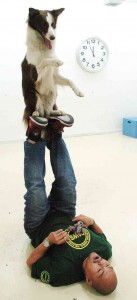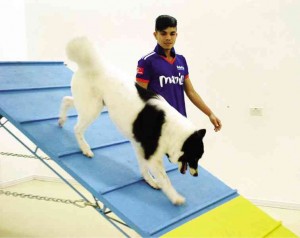
Skye, the cute little Jack Russell terrier owned by businessman Chardy Ang, can’t weigh more than six pounds, and can be snugly carried in one hand.
Let her loose to perform, however, and the spitfire shows why she’s appropriately named, flying over hurdles, standing on her front legs, and streaking through tunnels like the champion she is.
On May 25 and 26, Skye, along with Ang’s other star canine, the frisbee-catching Border Collie, Yuri, will be among the competitors to watch at the First Philippine Dog Agility Association (PDAA) Championships in Cebu City.

“This year, we’ve formalized the association and we’re putting in systems, and we hope this event can draw attention to how our dogs can do these wonderful things,” says PDAA president Jojo Isorena of Manila’s BetterDog Canine Behavior Center.
The event is significant for several reasons. First, it’s the first competition of such a scale by the PDAA, which was established August 28, 2005, in General Santos City and is composed of the country’s top dog training clubs and schools, such as the Obedience K9 Club of Negros (Bacolod), the Socksargen Canine Sports Club (GenSan), the Davao Dog Agility Unified Group (Davao), the K9 Cebu Agility Run Enthusiast (Cebu), the Western Mindanao Canine Agility Club (Zamboanga), and BetterDog.
The aim of the organization is to promote the growth of the fun and dynamic sport of dog agility, which includes such events as jumping (clearing hurdles, a beginners’ course); starters and advanced standard agility (involving a set obstacle course, in which a handler guides the dog through); gamblers (an obstacle course involving a point system); and the exciting disc dog or frisbee event. The president of the United States Dog Agility Association, Kenneth Tasch, will be here to officiate the event.
Second, the association is sending an important message to dog owners all over the country. “Part of our advocacy is welfare, and part of welfare is doing something with your dogs,” says Isorena, who does a lot of work with animal welfare groups and is a champion of the Philippine asPin or asong Pinoy. “For me, mas maraming kawawa that are suffering in cages in the back of houses, even really nice dogs in posh villages.”
Bred for a purpose
Many unenlightened pet owners choose a fancy dog breed for the wrong reasons, Isorena says, not knowing that pure-bred dogs were, after all, “bred for a purpose—to hunt, to herd. It’s very abusive to buy one and put him in a cage. You have to know what breeds of dogs would make good companion dogs. If you’re 70 years old and just want to sit around, you don’t get a Labrador puppy. We want to educate people that a dog isn’t something you buy and then stuff in your backyard.”
Third, the competitors will include at least two asPins: Kahati, a dog adopted and trained by BetterDog resident trainer Brad Feliciano after he was rescued from an abusive home, and who came with a broken leg and some socialization issues; and Amiga, a dog rescued in Cebu by businessman Ryan Cabahug when he found her hanging around outside a carwash he owns and operates.
Isorena himself was sold on asPins after he adopted and trained Flipper, who was rescued and turned over to the Philippine Animal Welfare Society. Flipper was found tied beside the overflowing Pasig River in a storm; the despicable owner apparently didn’t want the puppy, and decided to drown him.
“He was completely trainable,” Isorena says. “In fact, when I get problematic dogs here who need to socialize, Flipper is my therapy dog—because there are some things humans can’t teach dogs. They can only learn it from other dogs.”
Feliciano, a former photojournalist and teacher, became a professional dog trainer in 2009 and is a graduate of the Karen Pryor Academy for Animal Training and Behavior in the US. He considers asPins “one of the most intelligent dog breeds, because they are so present to their surroundings. They wouldn’t survive on the streets if they weren’t smart. If Border Collies are considered the smartest dogs because they think, asPins overthink—to the extent that they end up not moving!”
The asPin’s deeply ingrained cautiousness and distrust from years of abuse is both a pro and a con—“a disadvantage because they don’t learn faster, but an advantage because you have to be a really good trainer. It becomes great practice in problem solving.”
The pair has been focusing on building up the dog’s leg strength and social skills. Last March, Kahati, who used to get spooked by crowds, won his first event; Feliciano is hoping for at least “a clean run in Cebu—and that he doesn’t bite anybody,” he says with a laugh. As for the name, Feliciano reveals it’s because Kahati shares everything equally with Feliciano’s other rescued asPin, Alab—“my time, my food, my car, my love, my patience.”
Cabahug, a Cebu-based industrial engineer and businessman, hooked up with fellow dog enthusiasts through social networking. “We shared ideas on how we can let our pet dogs live their lives to the fullest. Dog agility is one of the best programs because both the handler’s and the dog’s abilities come into play. It enhances the coordination and the bond between the two.”
Misconception
Cabahug also runs K9CARE and offers dog training classes, and he worked mainly with Border Collies and Shetland Sheepdogs—until he met Amiga.
“After the First Cebu National Dog Agility competition, people had the misconception that only pure-bred dogs can do agility. I wanted to prove them wrong,” Cabahug says. “I found Amiga when she was just a puppy. I brought her home and started training her the same way I trained my pure-bred pups. She was very shy and suspicious at first. She eventually overcame that with some human interaction. She now excels in dog agility and disc.”
In fact, among dog circles, Amiga is a certified disc phenomenon who can leap unbelievably high into the air. “Dogs are naturally born the same, regardless of breed,” Cabahug declares. “They only differ depending on how their owners and trainers handle them.”
If there’s anybody who brings dog handling to a new level, it’s Chardy Ang, who, aside from Skye and Yuri, also trains Border Collies Cheska and Andy and asPin Aw (that’s short for “aw-aw”).
In fact, Skye and Yuri may just qualify for international competition soon, while Cheska is a dazzler when it comes to freestyle dancing with her human.
Ang started training his dogs three years ago, and hooked up with Isorena through the Internet when he was looking for a frisbee trainer for the hyperactive Skye.
Isorena instead guided him along the more appropriate paths for his dogs; Ang is even a five-time “Talentadong Pinoy” winner for his jaw-dropping routine with Cheska.
Showing off for our photographer, he balances the lovely Yuri on his feet while he lies on his back, and the dog perches without quivering—proof positive of her absolute trust in her handler.
“All my dogs are hyperactive,” Ang says. “When we’re learning new tricks, we practice every day, even three times a day—but I always have to make it fun, or they won’t move forward. They see it as play. Otherwise, kung boring ka, eh di they would rather pay attention to the rat or the cat!”
Like all his BetterDog mentors, Ang is an advocate of positive reinforcement. “I would never have been able to do these things with Yuri, for example, without positive reinforcement.” Indeed, Yuri gets a round with her rope toy after every successful trick, and hears “I love you” a lot from Ang.
With practice, it takes about six months to train a dog to jump, and a year before the animal is ready for agility. Many competitors start their dogs early, at about 10 months.
A high-energy, athletic dog with a strong pack drive—that is, a dog that likes being with people—makes a good competitor, Isorena says. Meanwhile, a good trainer needs patience, a stable mind—“and you have to be healthy, please,” says Feliciano, a frisbee enthusiast and avid runner. “How can you run with your dog if you can’t keep up?”
All this for a trophy, the honor and purely psychic rewards that only true dog lovers understand. “You get a rush,” says Isorena. “That feeling when your dog does a trick for the first time,” Ang adds, shaking his head in awe. “You love what you do,” concludes Feliciano, “because you earn your dog’s trust.”
For more information on the First Philippine Dog Agility Championships, visit www.phildogagility.org or www.facebook.com/goPDAA. For additional information, contact BetterDog Canine Behavior Center in Manila at tel. no. 7549958.

